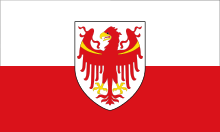Please tell us which country and city you'd like to see the weather in.

South Tyrol
South Tyrol (German and Ladin: Südtirol [ˈsyːtiˌroːl, ˈzyːttiˌʁoːl]; Italian: Sudtirolo [suttiˈrɔːlo]), also known by its alternative Italian name Alto Adige (pronounced [ˈalto ˈaːdidʒe]), is an autonomous province in northern Italy. It is one of the two autonomous provinces that make up the autonomous region of Trentino-Alto Adige/Südtirol. The province has an area of 7,400 square kilometres (2,857 sq mi) and a total population of 511,750 inhabitants (31.12.2011). Its capital is the city of Bolzano (German: Bozen; Ladin: Balsan or Bulsan).
According to 2014 data based on the 2011 census, 62.3 percent of the population speaks German (Standard German in the written norm and an Austro-Bavarian dialect in the spoken form); 23.4 percent of the population speaks Italian, mainly in and around the two largest cities (Bolzano and Merano); 4.1 percent speaks Ladin, a Rhaeto-Romance language; 10.2% of the population (mainly recent immigrants) speaks another language as first language.

South Tyrol wine
The Trentino-South Tyrol/Alto Adige area is an autonomous region located in north-east Italy producing wine in the two autonomous provinces of Trentino and South Tyrol. This Italian wine region is noted for the distinct German and Austrian influences on the wine industry due to the region's long history under the rule of Austria-Hungary and Holy Roman Empires.
Because of its unique history and location within the southern Alps and Dolomites, in this region grows a wide range of grape varieties that are not usually seen in other parts of Italy. These include Müller-Thurgau, Schiava, Lagrein, Sylvaner, Riesling (known locally as Riesling Renano), Gewürztraminer (known locally as Traminer Aromatico) and Blatterle.
Winemaking in the Province of South Tyrol
The name South Tyrol, in Italian Alto Adige, identifies the northern territory of the region that includes the higher (alto) part of the Adige River. Winemaking in South Tyrol has a long tradition: the first evidences date back to the period before the Romans. The South Tyrolean wine-growing area is highly influenced by the Mediterranean climate, which in the Adige valley (Bassa Atesina, Oltradige, Bolzano, Terlano, Burgraviato) arrives up to Merano. This allows a very versatile winemaking, which includes almost all the red grape varieties and a lot of white grape wines. The Val Venosta and the Valle Isarco have a harsher climate and thus they’re specialized in white wines. In South Tyrol there are three indigenous varieties: Schiava, Gewürztraminer and Lagrein.

Martell, South Tyrol
Martell (Italian: Martello) is a valley and comune (municipality) in South Tyrol in northern Italy. It is located in the Martell Valley of the 28.5-kilometre (17.7 mi) long river Plima, about 45 kilometres (28 mi) west of Bolzano. The commune reaches from an elevation of 957 metres (3,140 ft) up to the 3,757 metres (12,326 ft) of the Zufallspitze (Italian: Monte Cevedale) which towers over the southeastern end of the valley.
Geography
As of 30 November 2010, it had a population of 884 and an area of 143.7 square kilometres (55.5 sq mi).
Martell borders mainly to the municipality of Latsch at the bottom of the valley. Other neighbors based in the Vinschgau of the Adige are Stilfs, Laas and Schlanders. Ulten is in the neighboring valley to the East, while Peio, Rabbi and Valfurva are to the south.
Frazioni
Apart from the main village of Gand (Ganda), the municipality of Martell contains the frazioni (subdivisions, mainly villages and hamlets) of Ennetal (Val d'Enne), Ennewasser (Transacqua), Gand (Ganda), Meiern, and Sonnenberg (Montesole), as well as several farms and hotels.
Radio Stations - Trentino-Alto Adige
SEARCH FOR RADIOS
Podcasts:

